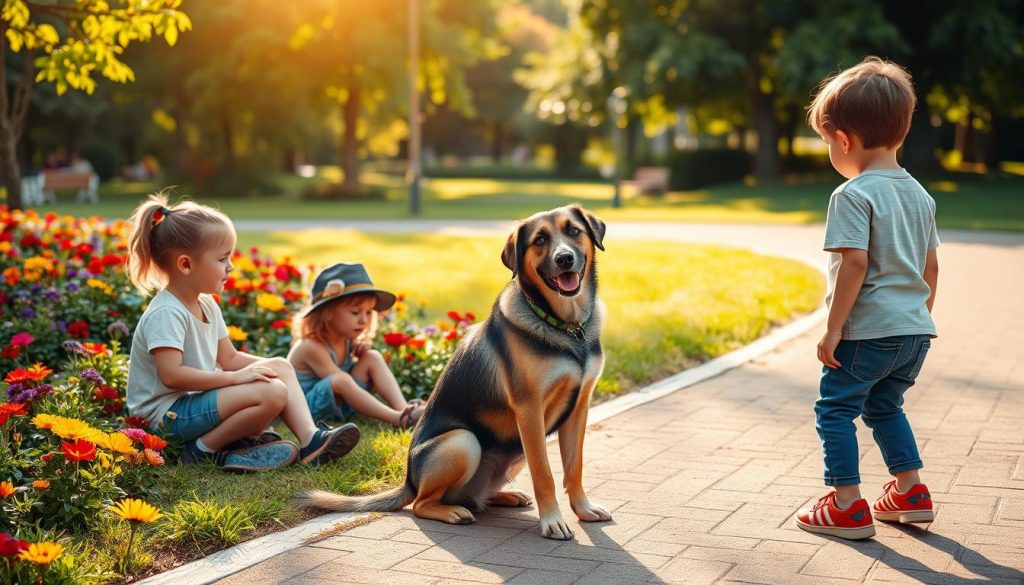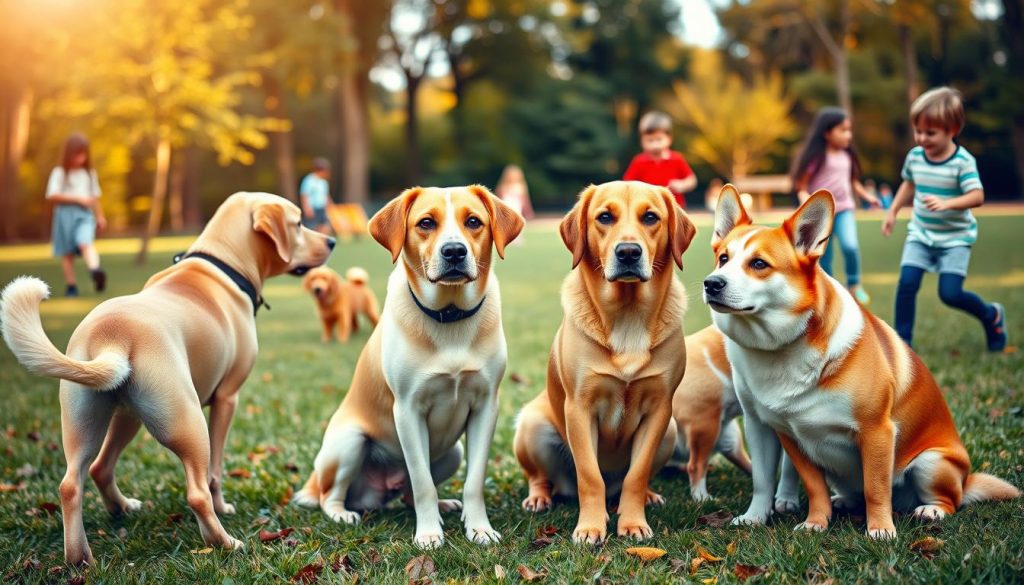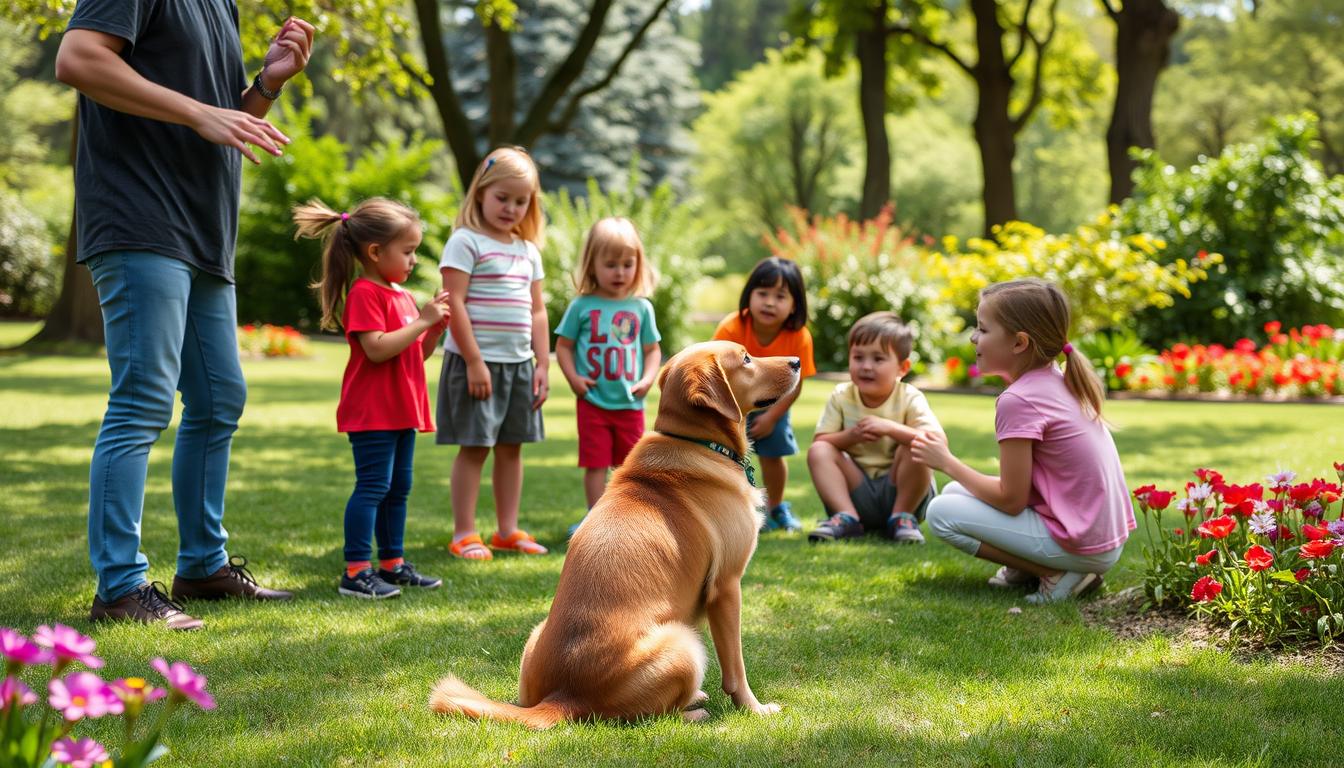Ever wondered why some dogs are calm around kids while others get overwhelmed? Let’s explore the key dog training tips to make your pet a great friend for kids. With more families having pets, knowing how to change a dog’s behavior is vital. This knowledge helps avoid accidents and strengthens the bond between you and your pet. Are you ready to learn how to keep your dog calm?
The Importance of Training Your Dog
Training your dog is key for their happiness and your peace of mind. It helps prevent dog bites. The American Veterinary Society of Animal Behavior (AVSAB) says trained dogs are less aggressive.
Being a good pet owner means more than just feeding and grooming. It’s about teaching your dog to greet others right. A well-trained dog handles social situations better, lowering the chance of bad interactions.
Training also boosts your dog’s mental health. Dogs need mental challenges to be happy, and training gives them that. It also strengthens your bond, making life together better.

Quick Recommendation : Our blog is filled with tips , tricks, and methods for training your dog. If you would like to attend a Free Dog Training Workshop, we recommend the K9 Training Institute , give it a try.
Training shows you’re a responsible pet owner. It teaches your dog to follow rules, keeping your home safe, especially for kids.
Training your dog brings lasting benefits for both of you. It leads to a happier, more harmonious home life.
Understanding Dog Behavior Around Children
Ensuring safe interactions between children and dogs starts with understanding dog body language. Dogs mainly communicate through their body language. It’s key to know these signs to avoid accidents. For example, a wagging tail doesn’t always mean a dog is happy. It can also show excitement or anxiety.

Quick Recommendation : Our blog is filled with tips , tricks, and methods for training your dog. If you would like to attend a Free Dog Training Workshop, we recommend the K9 Training Institute , give it a try.
Watch for signs of dog anxiety like yawning, licking lips, and avoiding eye contact. These signs mean your dog might be stressed or feeling overwhelmed, especially around active kids. Spotting these signs early helps calm the dog before things get worse.
It’s important to watch both children and dogs when they’re together. Teach kids to read a dog’s body language too. Signs like a stiff body or raised hackles mean the dog is not comfortable. This helps everyone understand and respect each other, making interactions safer and more fun.
Basic Obedience Commands
Teaching your dog basic commands like ‘sit,’ ‘stay,’ and ‘come’ is key for a well-behaved pet. It improves communication and keeps your dog safe. It also strengthens your bond with them.
To teach sit and stay, start in a quiet place without distractions. Hold a treat near your dog’s nose and move it up. This makes them follow the treat and sit down.
When they sit, say “sit” and give them the treat. Praise them a lot. Do this many times a day to make the command strong.
To teach stay, have them sit first. Then, open your hand and say “stay.” Take a few steps back and then come back to reward them. As they get better, you can go further and stay longer.
Be patient and keep practicing these commands. Using methods from the Certification Council for Professional Dog Trainers (CCPDT) is a good idea. The benefits of obedience training make it all worth it, creating a happy and harmonious relationship with your dog.
Proper Socialization Techniques
Socializing your dog is key for a well-behaved pet, especially when introducing them to kids. The American Kennel Club (AKC) provides guidelines for positive interactions with children. It’s important to be patient and careful at each stage.
When socializing with toddlers, keep a close eye on interactions. Toddlers can be unpredictable, so a calm environment is crucial. Start by letting your dog watch kids from afar, then gradually bring them closer as they both get more comfortable.
With older kids, teach them how to approach and handle dogs gently. Encourage them to avoid sudden movements or loud noises. This helps your dog feel more at ease. Teach kids to read dog body language to know when a dog is stressed.
To introduce your dog to different ages, start with short, calm meetings. Gradually increase the time and activity level. Socializing in places like parks or dog-friendly events helps your dog become more adaptable and confident around kids. Always reward your dog with treats and praise for good behavior.
Proper socialization and consistent training are essential for dogs and kids to get along well. By focusing on these early interactions, you build a strong bond based on trust and respect.
Positive Reinforcement Methods
Training your dog can be rewarding when you use positive methods. These methods focus on rewarding good behavior, not punishing bad. This creates a positive learning space for your pet.
Using dog treats as rewards is very effective. When your dog does something good, give them a treat. This reinforces the good behavior and makes them more likely to do it again. It makes training fun for both you and your dog, as it creates a positive link with commands.
The Journal of Veterinary Behavior says positive reinforcement is best for dog training. Dogs trained with rewards show less fear and anxiety. Rewarding good behavior makes your dog feel safe and confident, improving their overall happiness.
Being consistent is crucial in positive training. Always have treats ready during training and reward your dog right after they do something good. This quick feedback helps them understand the link between their actions and rewards, speeding up learning.
Adding dog treats to your training routine does more than just teach good behavior. It also strengthens your bond with your pet. A happy, well-behaved dog brings joy to any home, making the effort into positive reinforcement methods worthwhile.
Quick Recommendation : Our blog is filled with tips , tricks, and methods for training your dog. If you would like to attend a Free Dog Training Workshop, we recommend the K9 Training Institute , give it a try.
Creating a Safe Environment
Creating a safe space for kids and pets needs careful planning. Dog-proofing your home is key to keeping everyone safe. Start by checking each room for dangers like exposed wires, toxic plants, or small items that can be swallowed.
Setting up special areas for your dog helps everyone live together better. Think about a quiet spot with their favorite bed and toys. This can be a place for them to relax and feel safe, especially when it’s busy or loud.
Teaching kids how to be gentle with pets is crucial. They should learn not to do things that might scare or upset the dog. The Pet Professional Guild suggests using baby gates to keep kids and dogs apart when needed.
Also, make sure your dog’s food and medicine are safe from kids. Always watch when kids and dogs are together. This way, you can stop any problems right away.
By following these steps, you can make your home safer for everyone. Teaching kids to respect pets and keeping your dog safe helps everyone live in peace. This is good for both your kids and your pets.
Dealing with Negative Behaviors
Managing dog aggression, redirecting chewing and biting, and stopping excessive barking can be tough. But, it’s doable with the right approach. First, understand why your dog behaves a certain way. Then, use training and behavior changes to fix these issues.
The International Association of Animal Behavior Consultants (IAABC) suggests advanced behavior modification. For dog aggression, make sure your dog feels safe. Reward calm behavior and avoid things that make them aggressive.
To stop chewing and biting, give your dog the right chew toys. This keeps them busy. If they chew on the wrong thing, gently guide them to their toys and praise them.
Excessive barking can be solved by finding out why it happens. It might be boredom, anxiety, or alerting you. Teach your dog a “quiet” command and reward them when they use it.
Being proactive and consistent in managing these behaviors is key. It makes your home a better place for both you and your dog. Always be patient and use positive reinforcement.
Involving Children in the Training Process
Getting your kids involved in dog training is a great way to teach them responsibility and respect. It’s important to make sure they interact with pets safely and positively. This way, both your child and your dog will have a good time.
Teach your kids to be gentle and calm around dogs. Dogs can get scared or upset by loud noises or sudden movements. Knowing this helps create a peaceful space for everyone.
The Humane Society of the United States recommends starting with simple commands. Commands like “sit” or “stay” are easy for kids to learn. This helps the dog listen better and makes the child feel more confident.
It’s crucial to watch over your child and dog during training. This keeps everyone safe and helps the child learn better. Remember, being patient and consistent is important when teaching kids how to handle dogs.
Maintaining Consistency and Patience
Keeping up with consistent dog training routines is key. Dogs love routine, so regular training sessions are important. This helps them learn what you expect from them.
Being patient with dog training is also vital. It’s normal to get frustrated when your dog doesn’t learn fast. But, remember, every dog learns differently. Stay calm and give them the time they need to learn.
Using long-term pet behavior strategies is crucial for lasting results. Stick to the same commands and rewards over time. Dogs need consistency to learn new behaviors well. Professional trainers say to keep training sessions short but regular.
Consistency and patience are the heart of successful dog training. It’s not just about teaching commands. It’s about building trust and understanding. Stick with it, and you’ll see a well-behaved, happy dog in the end.
Conclusion
Training your dog to get along with kids is a journey that brings joy to both you and your pet. This article has given you the tools to make sure your dog stays calm and friendly around children. No matter if you’re new to pet parenting or have experience, each part of this article offers useful tips.
We’ve talked about the key training techniques, like basic commands, socialization, and positive feedback. These steps are vital for a safe space for your dog and kids. It’s also important to correct bad behaviors to keep peace at home. Letting kids help with training makes it fun and strengthens their bond with the pet.
Being consistent and patient is key to keeping your dog’s good habits going. Keep learning about dog behavior and use resources from places like the American Animal Hospital Association (AAHA). Staying up-to-date with the latest training methods will help a lot. With dedication, you can achieve great results in training your dog.
Quick Recommendation : Our blog is filled with tips , tricks, and methods for training your dog. If you would like to attend a Free Dog Training Workshop, we recommend the K9 Training Institute , give it a try.

